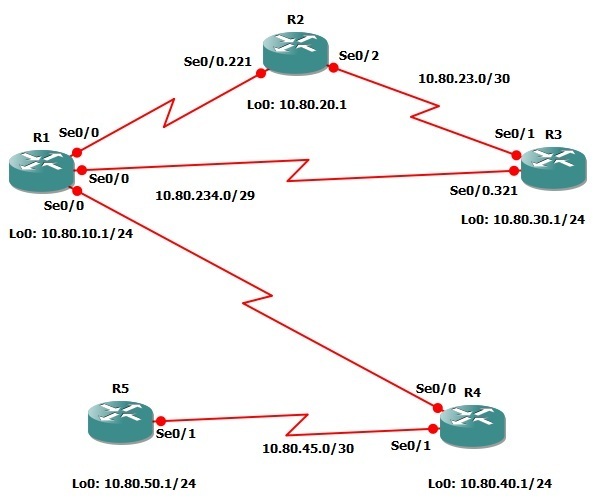Configuring EIGRP Route Summarization
EIGRP Route summarization is used to conserve resources and clean up the routing table. It can also advanced route engineering based on route summaries and longest match. This lab will discuss and demonstrate the configuration and verification of EIGRP Route summarization.
Real World Application & Core Knowledge
If you completed Lab 7-8 – Configuring RIP Route Summarization then you should have a basic understanding of how route summarization works. If you did not then to sum it all up; its basically the operation at which you subnet different subnets into a single larger subnet which gets advertised to neighboring routers to conserve router resources. For example, if you advertise a /22 subnet which encompasses four single /24 networks then you’re effectively cutting the resource requirements of neighboring routers by 75%; in which case an upstream router will have a single /22 route instead of four /24 routes to the same geographic location.
Configuring a summary address for EIGRP is done on a per interface basis uses practically the same command as configuring a summary address for RIP however there is a slight difference. When configuring a summary address on an interface for EIGRP you’ll use the ip summary-address eigrp AS# n.n.n.n s.s.s.s.s command whereas RIP uses the ip summary-address rip n.n.n.n s.s.s.s
Another benefit of using summary routes (aka: route aggregation) is if a single route goes down that is contained within a summary route, updates are not sent throughout the entire routed domain. Only the router advertising the summary route will know that the more specific route has went down. For EIGRP, this will prevent unwanted queries and potentially SIA in the EIGRP autonomous system.
In this lab you will configure four new loopback interfaces on R1 and configure a summary route on R1 advertised out the Frame-relay hub-and-spoke interface as well as the point-to-point interface towards R2.
Familiarize yourself with the following new command(s);
| Command | Description |
|---|---|
| ip summary-address eigrp AS# n.n.n.n s.s.s.s.s | This command is executed in interface configuration mode to configure an EIGRP summary route to be advertised out a specific interface. |
This lab will continue to build upon the topology previously used in Lab 8-7 and other labs found through out Section 8.

Lab Prerequisites
- If you are using GNS3 than load the Free CCNA Workbook GNS3 topology than start devices; R1, R2, R3, R4 and R5.
- Establish a console session with devices R1, R2, R3, R4 and R5 than load the initial configurations provided below by copying the config from the textbox and pasting it into the respected routers console.
Lab Objectives
- Configure four new loopback interfaces on R1 using the numbers 4-7, configure these interfaces with the ip address range 10.122.4.0/22. Tip: The 3rd octet as the interface number.
- Configure a single network statement to encompass the four newly created loopback interfaces.
- On R1 configure a summary address of 10.122.4.0/22 to be advertised out both the frame-relay hub-and-spoke interface.
- Verify the summary address is being propagated correctly by viewing he routing table on R5.
Lab Instruction
Objective 1. – Configure four new loopback interfaces on R1 using the numbers 4-7, configure these interfaces with the ip address range 10.122.4.0/22. Tip: The 3rd octet as the interface number.
R1>enable R1#configure terminal Enter configuration commands, one per line. End with CNTL/Z. R1(config)#interface loopback4 %LINEPROTO-5-UPDOWN: Line protocol on Interface Loopback4, changed state to up R1(config-if)#ip add 10.122.4.1 255.255.255.0 R1(config-if)#interface loopback5 %LINEPROTO-5-UPDOWN: Line protocol on Interface Loopback5, changed state to up R1(config-if)#ip address 10.122.5.1 255.255.255.0 R1(config-if)#interface loopback6 %LINEPROTO-5-UPDOWN: Line protocol on Interface Loopback6, changed state to up R1(config-if)#ip add 10.122.6.1 255.255.255.0 R1(config-if)#interface loopback 7 %LINEPROTO-5-UPDOWN: Line protocol on Interface Loopback7, changed state to up R1(config-if)#ip add 10.122.7.1 255.255.255.0 R1(config-if)#exit R1(config)#
Objective 2. – Configure a single network statement to encompass the four newly created loopback interfaces.
R1(config)#router eigrp 10 R1(config-router)#network 10.122.4.0 0.0.3.255 R1(config-router)#exit R1(config)#
Objective 3. – On R1 configure a summary address of 10.122.4.0/22 to be advertised out both the frame-relay hub-and-spoke interface.
R1(config)#interface Serial0/0 R1(config-if)#ip summary-address eigrp 10 10.122.4.0 255.255.252.0 %DUAL-5-NBRCHANGE: IP-EIGRP(0) 10: Neighbor 10.80.234.4 (Serial0/0) is resync: summary configured %DUAL-5-NBRCHANGE: IP-EIGRP(0) 10: Neighbor 10.80.234.3 (Serial0/0) is resync: summary configured %DUAL-5-NBRCHANGE: IP-EIGRP(0) 10: Neighbor 10.80.234.2 (Serial0/0) is resync: summary configured R1(config-if)#end R1# %SYS-5-CONFIG_I: Configured from console by console R1#
Objective 4. – Verify the summary address is being propagated correctly by viewing he routing table on R5.
R5>show ip route
Codes: C - connected, S - static, R - RIP, M - mobile, B - BGP
D - EIGRP, EX - EIGRP external, O - OSPF, IA - OSPF inter area
N1 - OSPF NSSA external type 1, N2 - OSPF NSSA external type 2
E1 - OSPF external type 1, E2 - OSPF external type 2
i - IS-IS, su - IS-IS summary, L1 - IS-IS level-1, L2 - IS-IS level-2
ia - IS-IS inter area, * - candidate default, U - per-user static route
o - ODR, P - periodic downloaded static route
Gateway of last resort is not set
10.80.0.0/8 is variably subnetted, 13 subnets, 5 masks
C 10.80.50.0/24 is directly connected, Loopback0
D 10.80.40.0/24 [90/2297856] via 10.80.45.1, 01:43:54, Serial0/1
D 10.80.23.1/32 [90/3705856] via 10.80.45.1, 01:43:54, Serial0/1
D 10.80.23.0/30 [90/3705856] via 10.80.45.1, 01:43:54, Serial0/1
D 10.80.23.2/32 [90/3705856] via 10.80.45.1, 01:43:54, Serial0/1
D 10.80.30.0/24 [90/3321856] via 10.80.45.1, 01:43:54, Serial0/1
C 10.80.45.1/32 is directly connected, Serial0/1
C 10.80.45.0/30 is directly connected, Serial0/1
D 10.80.20.0/24 [90/3321856] via 10.80.45.1, 01:43:54, Serial0/1
D 10.80.10.0/24 [90/2809856] via 10.80.45.1, 01:43:54, Serial0/1
C 10.50.0.0/24 is directly connected, Loopback5
D 10.122.4.0/22 [90/2809856] via 10.80.45.1, 00:05:37, Serial0/1
D 10.80.234.0/29 [90/2681856] via 10.80.45.1, 01:43:55, Serial0/1
R5>
